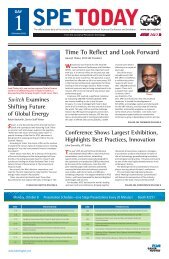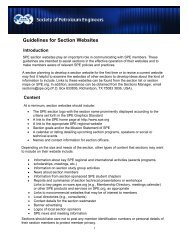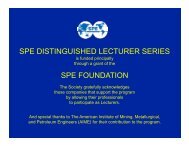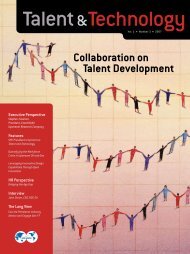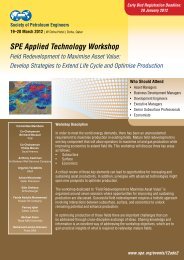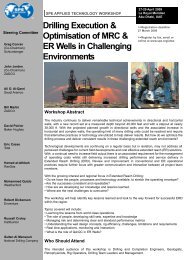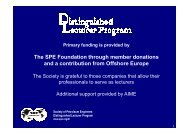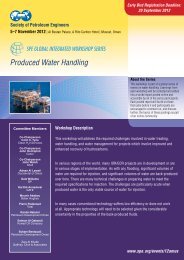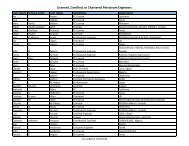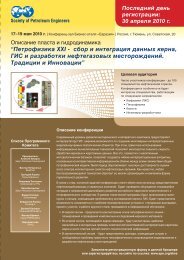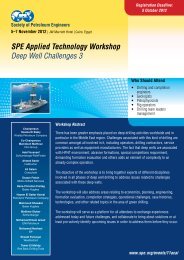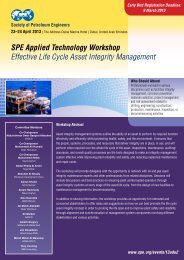Hydraulic Fracturing in Russia - Society of Petroleum Engineers
Hydraulic Fracturing in Russia - Society of Petroleum Engineers
Hydraulic Fracturing in Russia - Society of Petroleum Engineers
Create successful ePaper yourself
Turn your PDF publications into a flip-book with our unique Google optimized e-Paper software.
Register by 10 September 2010<br />
<strong>Society</strong> <strong>of</strong> <strong>Petroleum</strong> Eng<strong>in</strong>eers<br />
28–30 September 2010<br />
Conference Hall <strong>of</strong> TNK-BP Company | 14, Kuzovatk<strong>in</strong>a street, TNK-BP <strong>of</strong>fice | Nizhnevartovsk, Western Siberia, <strong>Russia</strong><br />
<strong>Hydraulic</strong> <strong>Fractur<strong>in</strong>g</strong> <strong>in</strong> <strong>Russia</strong>:<br />
Current Experience and Perspectives<br />
Who Should Attend<br />
• E&P company personnel <strong>in</strong>volved <strong>in</strong> field<br />
development plann<strong>in</strong>g<br />
• Completion and Stimulation Eng<strong>in</strong>eers<br />
• Eng<strong>in</strong>eers carry<strong>in</strong>g out hydraulic fractur<strong>in</strong>g<br />
activities and look<strong>in</strong>g to expand the<br />
application <strong>of</strong> their knowledge to different<br />
reservoir types<br />
• Service company staff <strong>of</strong>fer<strong>in</strong>g products<br />
and technologies for hydraulic fractur<strong>in</strong>g<br />
Program Committee<br />
Co-chairperson:<br />
Suleyman Sitdikov<br />
Rosneft<br />
Co-chairperson:<br />
Andrey Dedur<strong>in</strong><br />
TNK-BP<br />
Alexander Bogdanov<br />
CAToil<br />
Brian Davidson<br />
Carbo Ceramics<br />
Philippe Enkababian<br />
Schlumberger<br />
Ivan Kashtanov<br />
Gazpromneft<br />
Pavel Kuzovenkov<br />
Russneft<br />
Vladimir Makienko<br />
Lukoil West Siberia<br />
Andrey Mikh<strong>in</strong><br />
Lukoil Eng<strong>in</strong>eer<strong>in</strong>g<br />
Maxim Mikit<strong>in</strong><br />
Trican Well Services<br />
Murray Pike<br />
Trican Well Services<br />
Anton<strong>in</strong>a Prudnikova<br />
Halliburton<br />
Pavel Rus<strong>in</strong>ov<br />
Fores Chemicals<br />
Workshop Description<br />
<strong>Hydraulic</strong> fractur<strong>in</strong>g, as a method <strong>of</strong> well stimulation, started <strong>in</strong> USA <strong>in</strong> the late n<strong>in</strong>eteen forties. In<br />
the Soviet Union it was employed for the first time <strong>in</strong> 1952. <strong>Hydraulic</strong> fractur<strong>in</strong>g was <strong>in</strong>itially a<br />
primarily completion method for <strong>in</strong>jection wells <strong>in</strong> the course <strong>of</strong> peripheral waterflood<strong>in</strong>g at that time,<br />
less <strong>of</strong>ten it was performed on oil wells. Later on <strong>in</strong> the former Soviet Union hydraulic fractur<strong>in</strong>g was<br />
done <strong>in</strong> oil wells with river sand employed as proppant material.<br />
When development <strong>of</strong> high production rate oil fields had started <strong>in</strong> Western Siberia, the <strong>in</strong>terest <strong>in</strong><br />
hydraulic fractur<strong>in</strong>g dissipated nearly completely. As a result, hydraulic fractur<strong>in</strong>g was not employed<br />
on a commercial scale <strong>in</strong> the <strong>Russia</strong>n petroleum <strong>in</strong>dustry between the early seventies and the end <strong>of</strong><br />
n<strong>in</strong>eties <strong>of</strong> the 20th century.<br />
The second com<strong>in</strong>g <strong>of</strong> hydraulic fractur<strong>in</strong>g took place consequently on dramatically worsened<br />
structure <strong>of</strong> reserves <strong>in</strong> <strong>Russia</strong> <strong>in</strong> the early 1990’s. It was employed not only as a production<br />
enhancement method but also as a commercially viable method <strong>of</strong> develop<strong>in</strong>g hydrocarbon<br />
accumulations <strong>in</strong> low permeability reservoirs. This was facilitated by availability <strong>of</strong> modern hydraulic<br />
fractur<strong>in</strong>g procedures adapted to specific geological conditions <strong>of</strong> the <strong>Russia</strong>n Federation. By now<br />
the <strong>Russia</strong>n oil and gas companies have accumulated substantial experience <strong>in</strong> hydraulic fractur<strong>in</strong>g<br />
operations under various geological conditions.<br />
Our goal is to ensure this Workshop is attended by representatives <strong>of</strong> the major operators and service<br />
companies and is an exemplar forum for a free dialogue that would <strong>of</strong>fer an opportunity for the<br />
experienced companies to share accumulated knowledge and to ga<strong>in</strong> knowledge for those <strong>in</strong> search<br />
<strong>of</strong> solutions.<br />
Workshop Objectives and Deliverables<br />
1. Evaluation and discussion <strong>of</strong> exist<strong>in</strong>g fractur<strong>in</strong>g experience <strong>in</strong> <strong>Russia</strong><br />
2. Exchange <strong>of</strong> ideas for future development <strong>of</strong> <strong>Russia</strong>’s fractur<strong>in</strong>g market.<br />
Register onl<strong>in</strong>e at www.spe.org/atws
<strong>Hydraulic</strong> <strong>Fractur<strong>in</strong>g</strong> <strong>in</strong> <strong>Russia</strong>: Current Experience and Perspectives<br />
Workshop Timetable<br />
Sponsorship Support<br />
Sponsorship support helps <strong>of</strong>fset the cost <strong>of</strong><br />
produc<strong>in</strong>g workshops and allows SPE to keep<br />
the attendance price with<strong>in</strong> reach <strong>of</strong> operationslevel<br />
<strong>in</strong>dividuals, those who benefit most from<br />
these technical workshops.<br />
Sponsors benefit both directly and <strong>in</strong>directly<br />
by hav<strong>in</strong>g their names associated with a<br />
specific workshop.<br />
While SPE prohibits any type <strong>of</strong> commercialism<br />
with<strong>in</strong> the conference hall itself, the society<br />
recognizes that sponsor<strong>in</strong>g companies <strong>of</strong>fer<br />
valuable <strong>in</strong>formation to attendees outside the<br />
technical sessions.<br />
Sponsorship Categories<br />
Sponsorship can be <strong>of</strong>fered <strong>in</strong> the follow<strong>in</strong>g<br />
categories:<br />
General Sponsorship - an organisation can<br />
make a general contribution to the workshop<br />
costs and be identified on all promotional<br />
literature as a “General Workshop Sponsor”.<br />
1) Audio-visual Equipment: this package<br />
covers the hire <strong>of</strong> the audio visual<br />
equipment <strong>in</strong>clud<strong>in</strong>g the microphones,<br />
sound system and data projection.<br />
2) Simultaneous Translation: the workshop<br />
will be simultaneously translated <strong>in</strong><br />
English and <strong>Russia</strong>n. This sponsorship<br />
covers the hire cost <strong>of</strong> the equipment<br />
and the translators.<br />
3) Workshop C<strong>of</strong>fee Breaks: there will be<br />
morn<strong>in</strong>g and afternoon c<strong>of</strong>fee breaks<br />
on each day <strong>of</strong> the workshop. Exclusive<br />
sponsorship for one or all workshop<br />
c<strong>of</strong>fee breaks.<br />
4) Workshop Lunches: there will be 3<br />
workshop lunches dur<strong>in</strong>g the event for<br />
all attendees. Exclusive sponsorship<br />
for one or all workshop lunches–please<br />
<strong>in</strong>dicate on the sponsorship form which<br />
day you would prefer.<br />
5) Reception: sponsorship <strong>of</strong> Even<strong>in</strong>g<br />
Reception for all Workshop participants<br />
Sponsorship Benefits<br />
For sponsors SPE <strong>of</strong>fers the follow<strong>in</strong>g benefits<br />
dur<strong>in</strong>g the Workshop<br />
• Display <strong>of</strong> company name and a black<br />
and white logo on Workshop site;<br />
• For c<strong>of</strong>fee breaks, lunches and reception<br />
sponsorship: display <strong>of</strong> company name<br />
and black and white logo <strong>in</strong> the area<br />
where the function takes place.<br />
• For audio-visual equipment and<br />
simultaneous translation sponsorship:<br />
display <strong>of</strong> logo and company name on<br />
acknowledgement slide, projected on<br />
screen at beg<strong>in</strong>n<strong>in</strong>g and end <strong>of</strong> session,<br />
and dur<strong>in</strong>g mid-session break for c<strong>of</strong>fee.<br />
For More Information<br />
For more detailed <strong>in</strong>formation with regard<br />
to sponsorship support, please contact<br />
Kar<strong>in</strong>a Kalmykova, tel. 7 495 748 35 88 or<br />
at kkalmykova@spe.org.<br />
Tuesday, 28 September 2010<br />
0845–0930 .............. SPE Registration, C<strong>of</strong>fee<br />
0930–0945 .............. Workshop Open<strong>in</strong>g<br />
0945–1030 .............. Session 1: Well Candidate & Treatment Selection<br />
1030–1100 .............. C<strong>of</strong>fee Break<br />
1100–1230 .............. Session 1: Cont<strong>in</strong>ued<br />
1230–1330 .............. Lunch<br />
1330–1500 .............. Session 2: Latest Technology Achievements <strong>in</strong> <strong>Hydraulic</strong><br />
<strong>Fractur<strong>in</strong>g</strong>. Specialized <strong>Hydraulic</strong> <strong>Fractur<strong>in</strong>g</strong> Techniques<br />
for Specifi c Geological Conditions<br />
1500–1530 .............. C<strong>of</strong>fee Break<br />
1530–1700 .............. Session 2: Cont<strong>in</strong>ued<br />
1730–1930 .............. Reception<br />
Wednesday, 29 September 2010<br />
0830–0900 .............. Morn<strong>in</strong>g C<strong>of</strong>fee<br />
0900–1030 .............. Session 3: Practical Application <strong>of</strong> Spatial Fracture<br />
Orientation Technology <strong>in</strong> Re-<strong>Fractur<strong>in</strong>g</strong>. Necessity<br />
and Effi ciency <strong>of</strong> Re-<strong>Fractur<strong>in</strong>g</strong> Operations<br />
1030–1100 .............. C<strong>of</strong>fee Break<br />
1100–1230 .............. Session 3: Cont<strong>in</strong>ued<br />
1230–1330 .............. Lunch<br />
1330–1500 .............. Session 4: Horizontal Well <strong>Fractur<strong>in</strong>g</strong><br />
1500–1530 ............. C<strong>of</strong>fee Break<br />
1530–1700 .............. Session 4: Cont<strong>in</strong>ued<br />
Thursday, 30 September 2010<br />
0830–0900 ............. Morn<strong>in</strong>g C<strong>of</strong>fee<br />
0900–1030 .............. Session 5: Acid <strong>Fractur<strong>in</strong>g</strong><br />
1030–1100 ............. C<strong>of</strong>fee Break<br />
1100–1230 .............. Session 5: Cont<strong>in</strong>ued<br />
1230–1330 .............. Lunch<br />
1330–1500 .............. Discussions<br />
1500–1530 .............. C<strong>of</strong>fee Break<br />
1530–1700 .............. Discussions: Cont<strong>in</strong>ued<br />
1700 ........................ Workshop Clos<strong>in</strong>g
Prelim<strong>in</strong>ary Technical Agenda<br />
Conference Hall <strong>of</strong> TNK-BP Company | Nizhnevartovsk, Western Siberia, <strong>Russia</strong><br />
Introduction<br />
A well-known say<strong>in</strong>g that describes the childhood goes: “When trees had been<br />
tall…” The childhood <strong>of</strong> hydraulic fractur<strong>in</strong>g <strong>in</strong> <strong>Russia</strong> took place <strong>in</strong> the early<br />
1990-s with the launch <strong>of</strong> <strong>Russia</strong>n-German and <strong>Russia</strong>n-Canadian fractur<strong>in</strong>g<br />
jo<strong>in</strong>t ventures. We were master<strong>in</strong>g a new bus<strong>in</strong>ess and like all children made<br />
childish mistakes at that time. We have been grow<strong>in</strong>g dur<strong>in</strong>g the past twenty<br />
years, trees no longer seem very tall and we have ga<strong>in</strong>ed a lot <strong>of</strong> knowledge<br />
and experience. The substantial scope <strong>of</strong> national and <strong>in</strong>ternational hydraulic<br />
fractur<strong>in</strong>g expertise has been accumulated <strong>in</strong> this country. However, there are<br />
some fundamental issues that, on the one hand, are very clear but on the other<br />
hand have some outstand<strong>in</strong>g implications that prevent us from consider<strong>in</strong>g<br />
those topics f<strong>in</strong>alized.<br />
Tuesday, 28 September 2010<br />
Session 1: Well Candidate & Treatment Selection<br />
Session Managers: S. Sitdikov, A. Bogdanov<br />
One <strong>of</strong> the current typical issues related to hydraulic fractur<strong>in</strong>g is selection<br />
<strong>of</strong> candidate wells. Everyth<strong>in</strong>g seems clear and logical. Everyone knows<br />
what sk<strong>in</strong> is and how to deal with it. Assessment methods <strong>of</strong> the current<br />
reservoir status also pose no problem except for a few little th<strong>in</strong>gs–operator’s<br />
unwill<strong>in</strong>gness to commit substantial funds to production test<strong>in</strong>g, as well as<br />
obsolete measur<strong>in</strong>g equipment, tons <strong>of</strong> articulation statement pr<strong>in</strong>touts that<br />
cannot be quickly processed and analyzed, and other trifles that prevent<br />
application <strong>of</strong> simple and logical approaches <strong>in</strong> order to evaluate well<br />
potential and to select a candidate for hydraulic fractur<strong>in</strong>g.<br />
We, <strong>Russia</strong>n eng<strong>in</strong>eers, have to undertake remarkable <strong>in</strong>genuity <strong>in</strong> order<br />
to atta<strong>in</strong> desired objectives. Sessions 1 and 2 will attempt to answer the<br />
questions about candidate selection under <strong>in</strong>sufficient <strong>in</strong>formation, about<br />
identify<strong>in</strong>g the most efficient procedures for specific wells and the latest<br />
special hydraulic fractur<strong>in</strong>g methods available on the <strong>Russia</strong>n market.<br />
Session 2: Latest Technology Achievements <strong>in</strong> <strong>Hydraulic</strong><br />
<strong>Fractur<strong>in</strong>g</strong>. Specialized <strong>Hydraulic</strong> <strong>Fractur<strong>in</strong>g</strong><br />
Techniques for Specifi c Geological Conditions<br />
Session Managers: S. Sitdikov, A. S. Mikh<strong>in</strong><br />
Nowadays the portion <strong>of</strong> the reserves that are difficult to recover <strong>in</strong> overall<br />
residual recoverable reserves amounts to more than 50% and it <strong>in</strong>creases<br />
every year. A major amount <strong>of</strong> hydraulic fractur<strong>in</strong>g jobs are limited to us<strong>in</strong>g<br />
the standard procedure employ<strong>in</strong>g the polymer-based aqueous solution as a<br />
fractur<strong>in</strong>g fluid. The partial gel breakdown leads to the significant decrease<br />
<strong>of</strong> the reservoir residual conductivity and the generated fracture as well as to<br />
nearly uncontrolled vertical propagation <strong>of</strong> fractures. All these effects result<br />
<strong>in</strong> high water cut production and failure to achieve the planned <strong>in</strong>cremental<br />
production rate <strong>of</strong> oil.<br />
A great number <strong>of</strong> hydraulic fractur<strong>in</strong>g jobs are carried out annually <strong>in</strong> order<br />
to ma<strong>in</strong>ta<strong>in</strong> high oil production level and to enhance efficiency <strong>of</strong> oilfield<br />
development, <strong>in</strong>clud<strong>in</strong>g <strong>in</strong> new drills, <strong>in</strong> horizontal wells and lateral holes,<br />
<strong>in</strong> cased and open holes, <strong>in</strong> cemented and uncemented wellbore <strong>in</strong>tervals.<br />
More <strong>of</strong>ten than not a projected goal <strong>in</strong> production rate is not achieved. The<br />
challenge <strong>of</strong> <strong>in</strong>creas<strong>in</strong>g oil production under worsen<strong>in</strong>g reserves structure<br />
necessitates a search for new eng<strong>in</strong>eer<strong>in</strong>g and technological solutions <strong>in</strong><br />
hydraulic fractur<strong>in</strong>g.<br />
This workshop will <strong>of</strong>fer a unique opportunity to learn about the latest<br />
achievements <strong>in</strong> hydraulic fractur<strong>in</strong>g technology that are widely used by the<br />
advanced oil companies worldwide. The conference will help the specialists<br />
clearly formulate specific tasks for themselves and identify way forward based<br />
on the <strong>in</strong>ternational experience.<br />
The key topics for discussion dur<strong>in</strong>g Sessions 1 & 2:<br />
• Pr<strong>in</strong>ciples for well candidate selection for hydraulic fractur<strong>in</strong>g.<br />
• Experience <strong>of</strong> various hydraulic fractur<strong>in</strong>g technology application under<br />
different geological conditions.<br />
• Development trends for hydraulic fractur<strong>in</strong>g technologies <strong>in</strong> order to meet<br />
<strong>Russia</strong>’s geological conditions<br />
Wednesday, 29 September 2010<br />
Session 3: Practical Application <strong>of</strong> Spatial Fracture Orientation<br />
Technology <strong>in</strong> Re-<strong>Fractur<strong>in</strong>g</strong>. Necessity and Effi ciency<br />
<strong>of</strong> Re-<strong>Fractur<strong>in</strong>g</strong> Operations.<br />
Session Managers: A. S. Mikh<strong>in</strong>, B. Davidson<br />
The past decade has witnessed significant changes <strong>in</strong> hydraulic fractur<strong>in</strong>g<br />
technology. Modern equipment, new fractur<strong>in</strong>g procedures, advanced<br />
s<strong>of</strong>tware tools for model<strong>in</strong>g and fractur<strong>in</strong>g technology efficiency assessment,<br />
modern systems <strong>of</strong> fractur<strong>in</strong>g target isolation are <strong>in</strong>tegrated <strong>in</strong>to operations<br />
on the broad scale both <strong>in</strong> <strong>Russia</strong> and <strong>in</strong>ternationally. They facilitate better<br />
adaptation <strong>of</strong> every component <strong>of</strong> a hydraulic fractur<strong>in</strong>g process to specific<br />
downhole conditions <strong>in</strong> order to achieve the best result. <strong>Russia</strong>n and western<br />
companies pay a lot <strong>of</strong> attention to master<strong>in</strong>g best modern hydraulic fractur<strong>in</strong>g<br />
procedures.<br />
At the current stage <strong>of</strong> many oilfield developments the unsatisfactory<br />
<strong>in</strong>tegration <strong>in</strong>to operations <strong>of</strong> new hydraulic fractur<strong>in</strong>g procedures is accounted<br />
for by the fact that the pr<strong>in</strong>cipal production well stock has undergone repeated<br />
hydraulic fractur<strong>in</strong>g stimulation with the same standard fractur<strong>in</strong>g procedure<br />
that varied only <strong>in</strong> the volume <strong>of</strong> proppant and work fluid.<br />
This session will <strong>of</strong>fer an opportunity to discuss some issues related to<br />
re-fractur<strong>in</strong>g:<br />
1. Does the need for re-fractur<strong>in</strong>g realistically exist?<br />
2. What is the maximum efficiency <strong>of</strong> such operations?<br />
3. What for is it required to change the spatial fracture orientation for refractur<strong>in</strong>g<br />
jobs performance?<br />
4. How this task is operationally carried out?<br />
Dur<strong>in</strong>g this session the follow<strong>in</strong>g critical areas will be explored <strong>in</strong> more detail:<br />
• Purpose and objectives <strong>of</strong> re-fractur<strong>in</strong>g treatments–Spatial Fracture<br />
Orientation Technology.<br />
• Theoretical framework for re-fractur<strong>in</strong>g operations with spatial fracture<br />
orientation technology.<br />
• Potential efficiency <strong>of</strong> re-fractur<strong>in</strong>g treatments.<br />
• Well candidate selection for re-fractur<strong>in</strong>g treatments.<br />
• Practical execution <strong>of</strong> re-fractur<strong>in</strong>g treatments.<br />
• Technologies and procedures employed for re-fractur<strong>in</strong>g operations.<br />
• Re-fractur<strong>in</strong>g case histories.<br />
• Re-fractur<strong>in</strong>g treatments control methods.<br />
• Practical execution <strong>of</strong> re-fractur<strong>in</strong>g treatments <strong>in</strong> non-standard reservoirs<br />
–bitum<strong>in</strong>ous shale, viscous oil, etc.<br />
• <strong>Fractur<strong>in</strong>g</strong> fluids and materials recommended for application at<br />
re-fractur<strong>in</strong>g treatments.<br />
• Re-fractur<strong>in</strong>g <strong>in</strong> horizontal wells.
Register by 10 September 2010<br />
Session 4: Horizontal Well <strong>Fractur<strong>in</strong>g</strong><br />
Session Managers: P. Kuzovenkov, M. Pike<br />
<strong>Fractur<strong>in</strong>g</strong> <strong>in</strong> horizontal wells has <strong>in</strong>creased <strong>in</strong> popularity <strong>in</strong> North America over the past decade. Technologies<br />
and fractur<strong>in</strong>g techniques <strong>in</strong> horizontal sections have enabled operators to significantly reduce field development<br />
costs and ga<strong>in</strong>ed access to previously uneconomical deposits. In the <strong>Russia</strong>n market, horizontal wells are<br />
commonly drilled but with m<strong>in</strong>imal fractur<strong>in</strong>g work completed. Currently many operators <strong>in</strong> <strong>Russia</strong> are<br />
<strong>in</strong>vestigat<strong>in</strong>g technologies and techniques to better take advantage <strong>of</strong> horizontal drill<strong>in</strong>g. The workshop will<br />
explore some <strong>of</strong> the practices around the world and discuss their viability to the unique <strong>Russia</strong>n market. Some <strong>of</strong><br />
the key topics to be discussed <strong>in</strong> the session <strong>in</strong>clude:<br />
• Reasons beh<strong>in</strong>d fractur<strong>in</strong>g <strong>in</strong> horizontal wells<br />
• Effective horizontal well design for effective fractur<strong>in</strong>g operations<br />
• Completion systems<br />
• <strong>Fractur<strong>in</strong>g</strong> techniques–how <strong>Russia</strong> differs from the World<br />
• Economics<br />
With regards to horizontal well drill<strong>in</strong>g and completion, our country is like with fractur<strong>in</strong>g <strong>in</strong> the early 1990s, <strong>in</strong><br />
the age <strong>of</strong> “tall trees” now. In many cases, we attempt to elim<strong>in</strong>ate errors made dur<strong>in</strong>g well drill<strong>in</strong>g by subsequent<br />
hydraulic fractur<strong>in</strong>g, efficiency <strong>of</strong> which, however, leaves much to be desired. Is it necessary to design the well<br />
horizontal section with consideration <strong>of</strong> a future possibility for hydraulic fractur<strong>in</strong>g? How many fractur<strong>in</strong>g jobs<br />
will be performed and <strong>in</strong> what plane with respect to the wellbore? What will be the well bottom design to ensure<br />
the fractur<strong>in</strong>g job efficiency? These and many other questions will be addressed dur<strong>in</strong>g this session.<br />
Thursday, 30 September 2010<br />
Session 5: Acid <strong>Fractur<strong>in</strong>g</strong><br />
Session Managers: A. Dedur<strong>in</strong>, Ph. Enkababian<br />
In this session we will speak about carbonate formations, the type <strong>of</strong> reservoir that is much friendlier to acid<br />
than to proppant. Such reservoir can produce the significant rates <strong>of</strong> fluid and oil provided that the correct<br />
treatments are applied. In this area some <strong>Russia</strong>n operators are still <strong>in</strong> the “tall trees” zone and the others have<br />
had significant improvements and accumulated sufficient experience.<br />
The ma<strong>in</strong> difference <strong>of</strong> acid hydraulic fractur<strong>in</strong>g from the classical fractur<strong>in</strong>g is that the geometry and flow<br />
capacity <strong>of</strong> created fractures are the most important aspects for standard fractur<strong>in</strong>g where the chemical reactions<br />
and mud pumps hydraulic horsepower are critical for acid fractur<strong>in</strong>g treatments. A great number <strong>of</strong> acid<br />
fractur<strong>in</strong>g methods are currently <strong>in</strong> use. They allow the well life extension through more uniform sweep <strong>of</strong> the<br />
treated reservoir, acid’s deep formation penetration with creation <strong>of</strong> efficient channels for oil flow, avoidance <strong>of</strong><br />
side chemical reaction development that damages the formation.<br />
There aga<strong>in</strong>, the fact that chemistry is go<strong>in</strong>g <strong>in</strong>to the forefront makes it necessary to consider comprehensive<br />
quality control <strong>of</strong> materials, chemicals and equipment utilized <strong>in</strong> hydraulic fractur<strong>in</strong>g.<br />
Stimulation <strong>of</strong> carbonate reservoirs is a daily occurrence around the world. <strong>Russia</strong> has reservoirs rang<strong>in</strong>g from<br />
developed reservoirs to newly explored reservoirs. No matter what the stage <strong>of</strong> development most reservoirs will<br />
undergo stimulation at some stage <strong>of</strong> their life. Many <strong>of</strong> the newly explored reservoirs have unique characteristics<br />
and pose new challenges to the <strong>in</strong>dustry. This session will explore some <strong>of</strong> the exist<strong>in</strong>g and new fractur<strong>in</strong>g and<br />
matrix acidiz<strong>in</strong>g technologies used <strong>in</strong> <strong>Russia</strong> and around the world through case studies.<br />
Dur<strong>in</strong>g this f<strong>in</strong>al workshop session those who overgrew their “trees” will share the experience with those who are<br />
still look<strong>in</strong>g at these “trees” from bottom to top. Some <strong>of</strong> the key topics to be discussed <strong>in</strong> the session <strong>in</strong>clude:<br />
• Requirements for reservoir characterization<br />
• Formation damage and candidate selection pr<strong>in</strong>ciples<br />
• Treatment fluid selection <strong>in</strong>clud<strong>in</strong>g quality assurance and quality control considerations<br />
• Select<strong>in</strong>g the correct stimulation technique<br />
• Stimulation evaluation—feedback for improvement<br />
Workshop guidel<strong>in</strong>es<br />
FORMAT<br />
The workshop will last for 3 days,<br />
1 st , 2 nd , 3 rd days are <strong>in</strong>formal<br />
sessions with a number <strong>of</strong> short<br />
presentations (15-20 m<strong>in</strong>) and<br />
discussions.<br />
ATTENDANCE<br />
Attendance will be limited to<br />
a maximum <strong>of</strong> 100 delegates<br />
with proven experience and/or<br />
knowledge <strong>of</strong> the subject areas<br />
be<strong>in</strong>g covered.<br />
CONTINUING EDUCATION UNITS<br />
The workshop qualifies for SPE<br />
Cont<strong>in</strong>u<strong>in</strong>g Education Units<br />
(CEUs), at the rate <strong>of</strong> 0.1 CEU<br />
per hour <strong>of</strong> attendance at the<br />
workshop<br />
SCRIBE’S REPORT<br />
The Program Committee will<br />
appo<strong>in</strong>t a scribe to make a<br />
full report <strong>of</strong> the workshop<br />
summariz<strong>in</strong>g all presentation and<br />
discussion materials. This report<br />
will be circulated to all attendees.<br />
The copyright <strong>of</strong> the scribe’s<br />
report will belong to SPE.<br />
ATTENDANCE CERTIFICATE<br />
All attendees will receive a<br />
certificate from SPE attest<strong>in</strong>g to<br />
their participation <strong>in</strong> the workshop.<br />
CANCELLATION POLICY<br />
Written notice received 30 days<br />
before the start<strong>in</strong>g date <strong>of</strong> the<br />
workshop entitles registrants to<br />
a 50% refund. There will be no<br />
refund for cancellations received<br />
after this time.<br />
PLEASE USE FORM ON BACK<br />
FOR REGISTRATION<br />
ATTENTION NON-MEMBERS:<br />
Jo<strong>in</strong> SPE dur<strong>in</strong>g this workshop<br />
and receive your first year’s<br />
(2010–2011) membership free.<br />
Submit your membership<br />
application form onsite.
REGISTRATION FORM<br />
<strong>Hydraulic</strong> <strong>Fractur<strong>in</strong>g</strong> <strong>in</strong> <strong>Russia</strong>: Current Experience and Perspectives<br />
28–30 September 2010 • Conference Hall <strong>of</strong> TNK-BP Company<br />
14, Kuzovatk<strong>in</strong>a street, TNK-BP <strong>of</strong>fice, Nizhnevartovsk, Western Siberia, <strong>Russia</strong><br />
10ANIZ<br />
Important: Attendance is limited and is not guaranteed.<br />
Early registration is recommended. Please pr<strong>in</strong>t or type <strong>in</strong> black <strong>in</strong>k.<br />
Registration / Payment Deadl<strong>in</strong>e:<br />
10 September 2010<br />
Title _________ First Name/Forename ________________________________________________ Middle Name ________________________<br />
Last/Family Name _________________________________________________________________ SPE Member? ❒ Yes<br />
❒ No<br />
Member No.___________________________________________________________ ❒ I’d like to receive free Yr 2010-2011 SPE membership<br />
Job Title ______________________________________________Company/Organisation ___________________________________________<br />
Street or P.O. Box Number ___________________________________________________________ City ______________________________<br />
State/Prov<strong>in</strong>ce ____________________________ Zip/Postal Code ______________________ Country ______________________________<br />
Telephone _______________________________________________________________ Facsimile ___________________________________<br />
Email (required) ______________________________________________________________________________________________________<br />
Bill<strong>in</strong>g Address:<br />
Street or P.O. Box Number ___________________________________________________________ City ______________________________<br />
State/Prov<strong>in</strong>ce ____________________________ Zip/Postal Code ______________________ Country ______________________________<br />
Would you be will<strong>in</strong>g for SPE to share your contact details with other delegates who attend this workshop? ❒ Yes ❒ No<br />
WORKSHOP<br />
Please <strong>in</strong>dicate which category below most accurately describes your job tite:<br />
❒ Geoscientist/Geologist ❒ Geophysicist ❒ Reservoir Eng<strong>in</strong>eer ❒ <strong>Petroleum</strong> Eng<strong>in</strong>eer<br />
❒ Drill<strong>in</strong>g and Completion Eng<strong>in</strong>eer ❒ Construction Eng<strong>in</strong>eer ❒ Economist ❒ Petrophysicists<br />
❒ Other please specify: __________________________________________________________________________________<br />
Applied Technology Workshop Fee:<br />
RESIDENTIAL RATE ❒ 38,200 Rubles (GBP 850) without VAT/person for Members ❒ 41,200 Rubles (GBP 915) without VAT/person for Nonmembers<br />
Residential Rate <strong>in</strong>cludes: Three-day registration for all Workshop sessions, 3 nights stay with breakfast at Samotlor or Ob Hotels <strong>in</strong> Nizhnevartovsk (standard room,<br />
s<strong>in</strong>gle occupancy), all workshop pr<strong>in</strong>ted materials and scribe’s report, lunches, daily c<strong>of</strong>fee/tea breaks, welcome reception on September 28 th , 2010.<br />
NON-RESIDENTIAL RATE ❒ 23,500 Rubles (GBP 520) without VAT/person for Members ❒ 26,500 Rubles (GBP 590) without VAT/person for Nonmembers<br />
Non-Residential Rate <strong>in</strong>cludes: Three-day registration for all Workshop sessions, all workshop pr<strong>in</strong>ted materials and scribe’s report, lunches, daily c<strong>of</strong>fee/tea breaks,<br />
welcome reception on September 28 th , 2010.<br />
Payment Details:<br />
❒ Bank Wire Transfer: For further details, please contact SPE Moscow <strong>of</strong>fice at kkalmykova@spe.org<br />
❒ Credit Card (Check One): ❒ American Express ❒ MasterCard ❒ Visa ❒ D<strong>in</strong>ers<br />
Written notice <strong>of</strong> cancellation received by 28 August 2010 entitles registrants to a 50% refund. There will be no refunds after this time.<br />
Card Number (will be billed through <strong>Society</strong> <strong>of</strong> <strong>Petroleum</strong> Eng<strong>in</strong>eers) Expiration Date (mm/yy)<br />
Name <strong>of</strong> Credit Card Holder: (pr<strong>in</strong>ted) __________________________________________________________________________________<br />
Signature: (required) _____________________________________________________________ Date: ____________________________<br />
Security Code: (3 digits on back <strong>of</strong> card / for AMEX 4 digits on front <strong>of</strong> card) ______________ Start Date: (D<strong>in</strong>ers only) _________________<br />
Mail, fax, or e-mail completed Registration Form with payment or credit card <strong>in</strong>formation to:<br />
<strong>Society</strong> <strong>of</strong> <strong>Petroleum</strong> Eng<strong>in</strong>eers Telephone: +7 495 748 35 88<br />
14, bld 1, <strong>of</strong>fice 15, Nizhnya Street, Fax: +7 495 748 35 88<br />
Moscow 125040<br />
Email: akozm<strong>in</strong>a@spe.org<br />
Submit registration onl<strong>in</strong>e at www.spe.org/atws<br />
Registration form will not be processed without payment unless authorized by meet<strong>in</strong>gs manager.<br />
For questions or additional <strong>in</strong>formation contact: Kar<strong>in</strong>a Kalmykova at kkalmykova@spe.org
Register by 10 September 2010<br />
<strong>Society</strong> <strong>of</strong> <strong>Petroleum</strong> Eng<strong>in</strong>eers<br />
28–30 September 2010<br />
Conference Hall <strong>of</strong> TNK-BP Company<br />
14, Kuzovatk<strong>in</strong>a street, TNK-BP <strong>of</strong>fice | Nizhnevartovsk, Western Siberia, <strong>Russia</strong><br />
WORKSHOP<br />
<strong>Hydraulic</strong> <strong>Fractur<strong>in</strong>g</strong> <strong>in</strong> <strong>Russia</strong>:<br />
Current Experience and Perspectives




